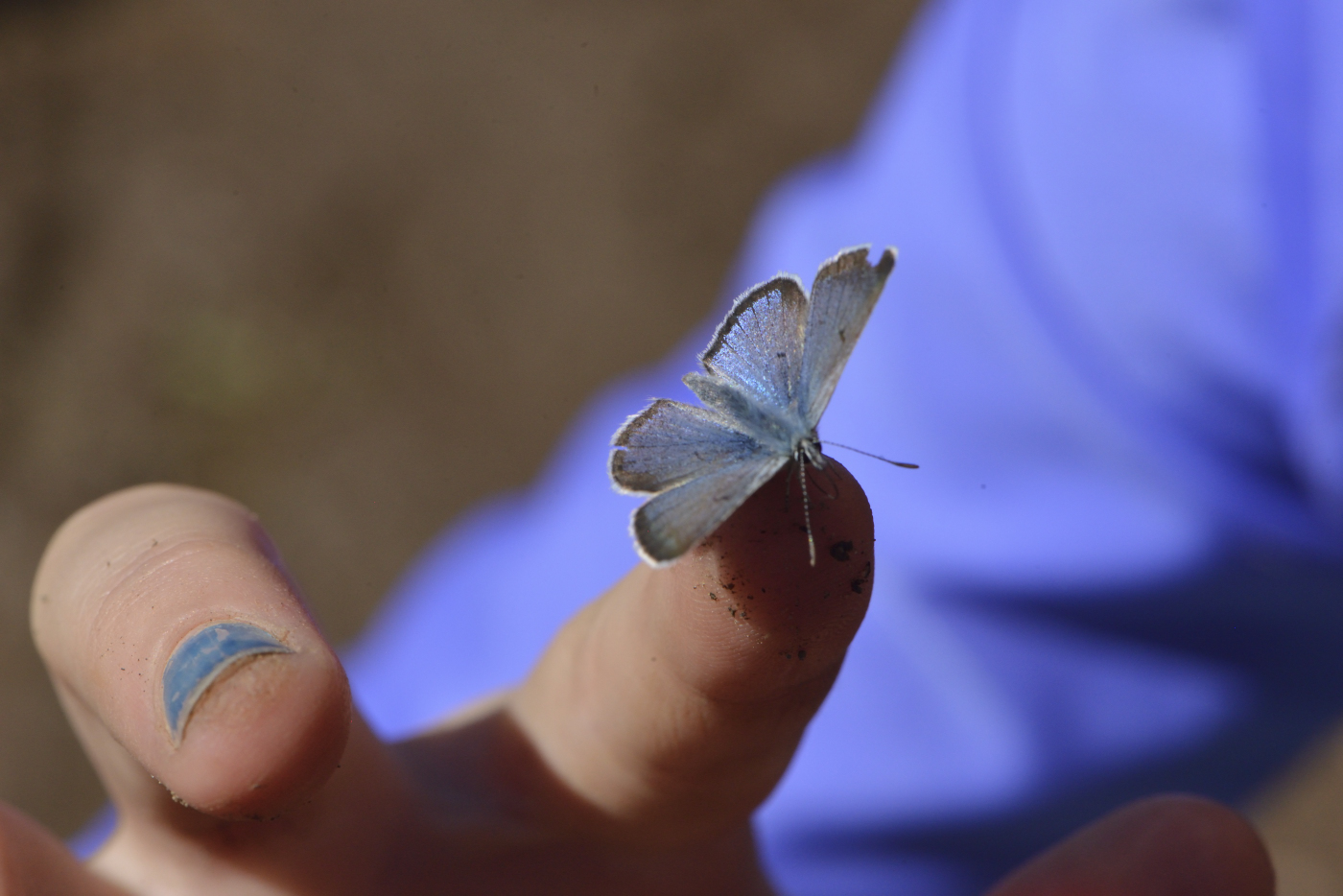Postcard from Camp Colton
Embedded with students at Camp Colton for several days and nights, local writer and editor Rose Houk and photographer and writer Michael Collier capture the essence of Camp.
Rose and Michael team up in life and sometimes work as well. Camp Colton was lucky to host them both as they generously donated their time and expertise to document and share the 6th grade student experience.
Check Out Camp Colton – A Film by Michael Collier
Postcard from Camp Colton by Rose Houk with Photos by Michael Collier

6th Grade student at Camp Colton
The big yellow FUSD No. 1 school bus pulls up to the entrance of Camp Colton, and the load of passengers pours out the door. Program coordinator Callie Harward, bullhorn in hand, welcomes the students with a “Hey Oh”—a call soon to become a trademark for “time to listen up.”
Callie instructs the students to form a “fire line” and start unloading all their gear. In ballcaps, t-shirts, and sunglasses, the kids straggle into line, handing off sleeping bags, pillows, blankets, duffle bags, and packs, some nearly as big as they are. One student clutches a stuffed animal, a bit of comfort away from home.
As they toss things along, the kids giggle and cut up, while their teacher, Daniel Wong, encourages them to be nice with the bedding. “Good job,” he adds.
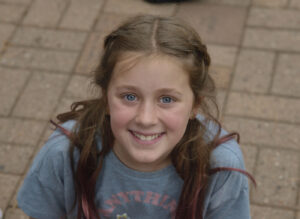
6th Grade student at Camp Colton
The controlled chaos takes a while, as the pile of gear grows into a mountain. The students gather in a circle, seated on log stumps, waiting for the second bus to arrive. But in minutes, a bunch scampers off like chipmunks to another row of stumps. One girl comments, “We’re literally out in the middle of nowhere.”
Indeed. These 65 sixth-graders from Sinagua Middle School have journeyed 10 miles from Flagstaff to Camp Colton, situated near 9,000 feet elevation at the foot of the San Francisco Peaks. It’s not that far in miles, but in these quiet woods away from home, family, and digital distractions, they’re in an entirely different world. For many, it’s the first time ever for this experience. On this late August morning, lupines bloom bluer than the sky, mushrooms are popping up, and deer with fawns browse in the woods. It’s anyone’s guess whether the students noticed them on the way in amid their nervous excitement.
****

Sinagua Middle School students arriving at Camp Colton
Camp Colton is operated by the Flagstaff Unified School District in partnership with Friends of Camp Colton. For 52 years, a four- or five-day stay here has been a rite of passage for all sixth graders. In that time, more than 47,000 have been hosted here. And nearly anyone you talk to in town is an alumni–or their children, parents, or siblings are.
It all began when two Secrist sixth-grade teachers, Ed Piper and Bob Dawson, along with principal Tony Gabaldon, started Project LIFE out at Mormon Lake. In 1976, Dick and Jean Wilson deeded 33 acres to the school district. Camp Colton was born, and named in honor of Dick’s mother Suzanne Colton Wilson. The Wilsons later gave the “next door” Fern Mountain Ranch to The Nature Conservancy for the Hart Prairie Preserve.
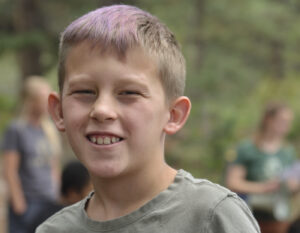
Sinagua Middle School student arriving at Camp Colton
Over that half century, camp has remained a residential environmental education program, off-grid and outdoors, free of classroom walls. The stated mission is to cultivate “exceptional outdoor learning experiences that instill the value of preserving our natural world and inspire growth and discovery.” The person in charge of carrying out that mission every day on the ground is camp director Jackson Carranco. A guy who never stops moving.
After the second bus arrives and unloads, Jackson rings the old cast iron bell outside the main lodge, a sound that will summon campers to come together throughout the week.
“What a blessing to see you all here,” he says, then moves right on to the basics. Boys and girls restrooms and showers behind the main lodge. Water spigots are there too, “straight from the spring where we get all our water.” Rooftop solar panels produce electricity.
Jackson also notes the dozen canvas-sided platform tents and two newer enclosed cabins where campers will spend their nights. And of course there are rules: no visiting friends in other tents, and no going back to the tents during recess without permission. And no food or trash inside, lest a porcupine find its way in.
Tents, eight bunks in each, are assigned and claimed. Blankets and sleeping bags are arranged; one girl stretches out and says, “mine is actually comfortable for some reason.” But there’s precious little time to relax. Instead, it’s back to the lodge porch where campers fill out their name tag “cookies”—rounds of wood on yarn string to be worn all the time, at least in theory. .
****
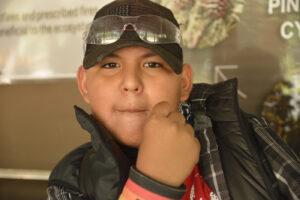
6th Grade student at Camp Colton
Outside on the patio, Jackson draws all eyes to the San Francisco Peaks towering to 12,000 feet just behind them. “We are really on the mountain” he observes, and inquires who knows the names of the Peaks. “Humphreys” says one, “Elden,” chimes another. A shy Navajo girl calls them Dook’o’oosłiid in her Diné language.
“What do you think about being outside? How can we treat this place?” Hands shoot up with answers—respect the animals, don’t pull grass or step on flowers, don’t dig holes. All good thoughts that will be reinforced as the campers participate in the various daily activities.
Animals become the theme as each student is then assigned to the group they’ll stay with through the week—Antelope, Bear, Chipmunk, Deer, and Elk. These are designed to fulfill another goal at Camp Colton. Team building and getting along with your peers and kids who aren’t part of your inner circle. For 11- and 12-year-olds, on the brink of adolescence, this is as important as the basic outdoor education mission.
Finally…lunch time! At picnic tables inside the main lodge dining room, cafeteria trays offer sandwiches, chips, carrots, cookies. Three meals a day are prepared in the adjoining kitchen, on a massive woodstove that’s fired up each morning.
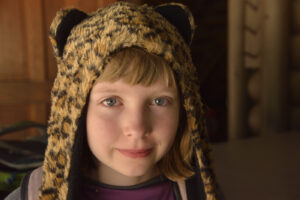
6th Grade Camp Colton student
Downtime is a disadvantage given the boundless energy of this age group. As soon as trays are cleared and cleanup crew is done, the jam-packed afternoon is in full swing. Topic is Adventure/Survival. The designated Animal groups rotate through four stations—orientation and games with Callie; orienteering with Jenaye where they learn old-fashioned compass and more modern GPS skills; Darcy sends them off to apply those skills to geocaching, finding hidden boxes. Nolan lines up two teams on either side of a rope, which is attached to pulleys. The winning team illustrates a fairly sophisticated science lesson on applying force over distance.
For the next two days, the smaller groups will venture farther afield on “expeditions.” Geology entails a trip into a cool, dark lava tube. Forestry covers trees, wildfire, and restoration. The ecosystem session illustrates the web of life. Aquatics teaches about hydrology and water creatures at a nearby water tank.
****
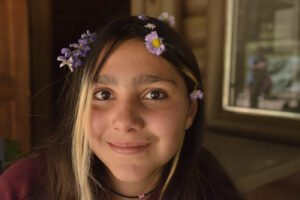
6th Grade student at Camp Colton
Meantime, it’s getting on into the afternoon. Campers meet Coconino County Search and Rescue volunteers, sharing real-life scenarios of hurt or lost hikers. The students’ comments and questions show this topic makes an impression, and they go away with tips to prevent the need for search and rescue in the first place.
One more activity rounds out this already very full first day. Several telescopes are set up in a nearby open field, courtesy of Northern Arizona University astronomer and volunteer Ed Anderson. After dinner, with headlamps and flashlights, the campers walk over, a bobbing line of fireflies. The Moon rises over the Peaks, within days of a stunning full Supermoon. Campers take turns looking through the eyepieces of the telescopes, observing lunar craters, the red giant star Arcturus, the double star in the handle of the Big Dipper, and a globular cluster.
At long last, it’s time to call it a day. The young campers return to their respective tents. Lights out, eyes closed, no whispering, says Callie. And though experience tells her there may be a few tears of homesickness at night, with luck there won’t be many. Instead, and it may take time, campers will discover something astounding about themselves and the natural world.

